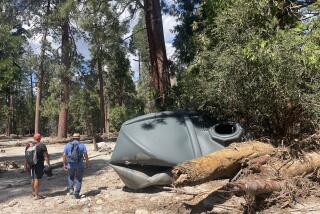Manzanar Building to Be Visitor Center
A decade after the Manzanar relocation camp was named a national historic site, work is set to begin on a $5-million project to turn one of its last remaining buildings into a visitors center.
The renovation is the most visible undertaking yet in a long effort to commemorate a dubious moment in U.S. history: the wartime roundup of Japanese Americans living on the West Coast.
More than 10,000 wound up at Manzanar, in a collection of wooden barracks thrown up on a barren piece of the Owens Valley 200 miles northeast of Los Angeles.
Most of the camp was dismantled after World War II. The large auditorium was left and used by Inyo County as a road maintenance facility.
The National Park Service, which oversees the site, expects to award bids for renovation of the auditorium within the next few weeks and start construction in the spring. A 2003 opening is planned for the building, which will house administrative offices and the visitors center, including exhibition space and theaters for presentations and the screening of a short film about the camp.
A wing that was removed will be rebuilt and another wing will be refurbished to reflect the wooden auditorium’s original appearance.
The effort to save Manzanar from oblivion has been slow and painstaking. The camp was designated a national historic site in 1992, 50 years after it was hastily erected under an executive order decreeing the resettlement of West Coast residents of Japanese descent.
About 120,000 were shipped to 10 camps in the West and Arkansas after America’s entry into World War II. Manzanar was the first site to open, and operated from 1942 to 1945. With a peak population of 10,000 crammed onto a square mile, it was the largest community between Los Angeles and Reno.
In attempting to retell Manzanar’s story, the park service is treading on sensitive ground. There has been a debate, for instance, over whether the site should be called a relocation center or a concentration camp.
“The [Japanese American] community is very much in favor of using the term ‘concentration camp,’ ” said Sue Embrey of Los Angeles, who was sent to Manzanar as a teenager and heads a nonprofit group dedicated to preserving it.
“To them, barbed-wire fences and guard towers and soldiers with rifles and searchlights at night means that--people concentrated,” said Embrey, recalling camp conditions.
The park service instead opted for “war relocation center.”
Still, Embrey said park service personnel are doing a good job of creating an accurate picture of life at Manzanar. “These people are really dedicated.”
It helps that there is an unusually large photographic record of the camp, said Manzanar Supt. Frank Hays. Some were taken by landscape photographer Ansel Adams, who spent much of his time in the Sierra Nevada, next door to Manzanar. Many were taken by Toyo Miyatake, an internee who smuggled a camera into the camp and eventually photographed life there with the consent of the Manzanar command. A home movie of the camp was even found.
The park service has put out a call for camp artifacts and buildings, many of which were hauled away to other parts of the Owens Valley after Manzanar was closed. Inyo County, Hays said, is going to donate a former camp mess hall that was later used as a hospital.
After the site was designated, it took years for the park service to arrange a land swap with the Los Angeles Department of Water and Power, which owned the camp property as part of its vast holdings in the Owens Valley.
Then Congress had to approve funding for the auditorium renovation. In the last couple of years, the park service has organized a driving tour of the site, reconstructed a barbed-wire fence around the camp core and restored sentry posts at the entrance off U.S. 395.
The park service hopes to eventually re-create a block of barracks as well as one of eight guard towers that ringed the camp perimeter. More funding will be needed to do that.
Embrey said that those who lived at Manzanar are eager to see the project move ahead.
“People who are former internees get very anxious to see something done before they die,” she said.
More to Read
Sign up for The Wild
We’ll help you find the best places to hike, bike and run, as well as the perfect silent spots for meditation and yoga.
You may occasionally receive promotional content from the Los Angeles Times.







